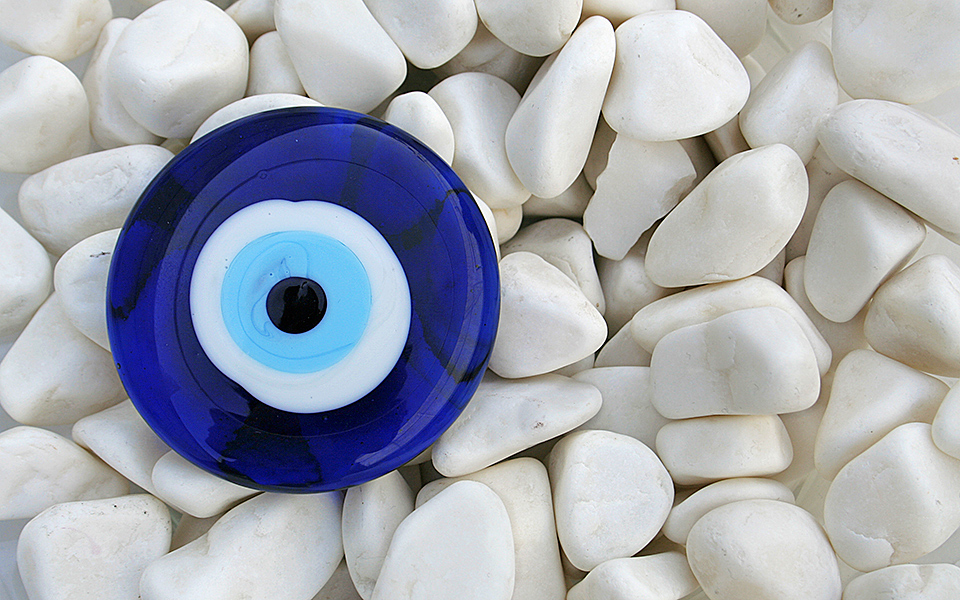“What is that… thing?” she said, pointing at the blue and turquoise bead pinned to the crib. “Is she trying to put a hex on my baby? I knew it, she has never liked me.” My English friend’s sister-in-law had just dropped by to welcome the new addition to the family and had left the offending article as a gift. Far from being a curse, the little thumbnail-sized piece of colored glass was a traditional good luck charm.
The purpose of the ‘mati’, a schematic representation of an eye, is to ward off the envious gaze, which, confusingly, is also known in Greek as ‘mati’. According to the tradition, anyone offering effusive praise risks giving the recipient the ‘evil eye’, which can bring illness or misfortune, even if the giver’s intentions are pure. Children are particularly susceptible to the evil eye, both because they are young and innocent, and because they are magnets for praise. All that cooing and clucking poses a risk, and a ‘mati’ charm is the first line of defense.
It has become commonplace to dismiss the notion of the ‘mati’ as a superstition, but the tradition of the charm persists, for new babies, new businesses, housewarmings and even new cars – any occasion when a ‘good luck’ wish is called for. Most gift shops stock at least one version and they are often to be found in souvenir shops. Their striking coloring mirrors the distinctive blue and white accents of Aegean island architecture, and offers visitors a tangible reminder of the blue seas and skies of Greece that can be carried on a key-ring or hung on the wall back home.
Most people don’t realize that the ‘mati’ is a concept of great antiquity, and although it has become part of the Orthodox Christian tradition it transcends religion. It is shared by the Muslim, Jewish and even Hindu civilizations across Eurasia, where it is commonly known as ‘nazar’.
One of the earliest explanations of the evil eye is recorded by the 1st-2nd century AD writer Plutarch. In his work ‘Moralia’, a group of guests at a symposium have an extended conversation on the subject of the evil eye, known as the ‘baskanos ophthalmos’, which sounds so familiar that it could have easily taken place at a dinner party last night. They discuss how children can be harmed by those who cast the evil eye, but so can adults if the envy is strong enough. Envy consumes the sufferer and emanates through their eyes. Is it true that loved ones can also give the evil eye? Even this can be explained. The person consumed by envy can’t control its influence, meaning that even those near and dear, friends, relatives, even fathers, can inflict harm without even realizing it.
Amulets and charms defending against the evil eye can be found dating back to the late Classical period, and seem to originate from Egypt before spreading throughout the Middle East. The most common colors are green and blue, probably because those are the least common eye colors among the populations of that region, and are viewed with superstition. The eye amulet is what is known as an ‘apotropaïc’ symbol, meaning ‘turning back’, as its purpose is literally to reflect the evil eye back on the person who casts it. Roman mosaic floors show other forms of defense against it: an eye is shown being pecked by birds and attacked by dogs, snakes and scorpions and stabbed with weapons.
Charms are only the first line of defense, but there are other ways of counteracting the ‘mati’ that foreigners might find bizarre, or even disturbing. If someone is concerned that the may be giving the evil eye, they can prevent it by spitting three times. This is also a custom that goes far back in time. In a poem by Theocritus dating to the 3rd century BC, the one-eyed giant Polyphemus gazes at his reflection in the sea, and finding his beard and his single eye to be beautiful and his teeth whiter than marble, takes the precaution of spitting on his chest three times to avoid bewitching himself.
The tradition lives on. Someone, usually a well-meaning auntie, can be counted on to spit (or feign spitting) on your newborn for good luck. I felt it was my duty to warn my friend about that one too, to prevent a family falling-out. Plus, she might need to call on that same auntie to cast a ‘xematiasma’ spell should a more serious case of the evil eye arise.
“It has become commonplace to dismiss the notion of the ‘mati’ as a superstition, but the tradition of the charm persists, for new babies, new businesses, housewarmings and even new cars – any occasion when a ‘good luck’ wish is called for.”











